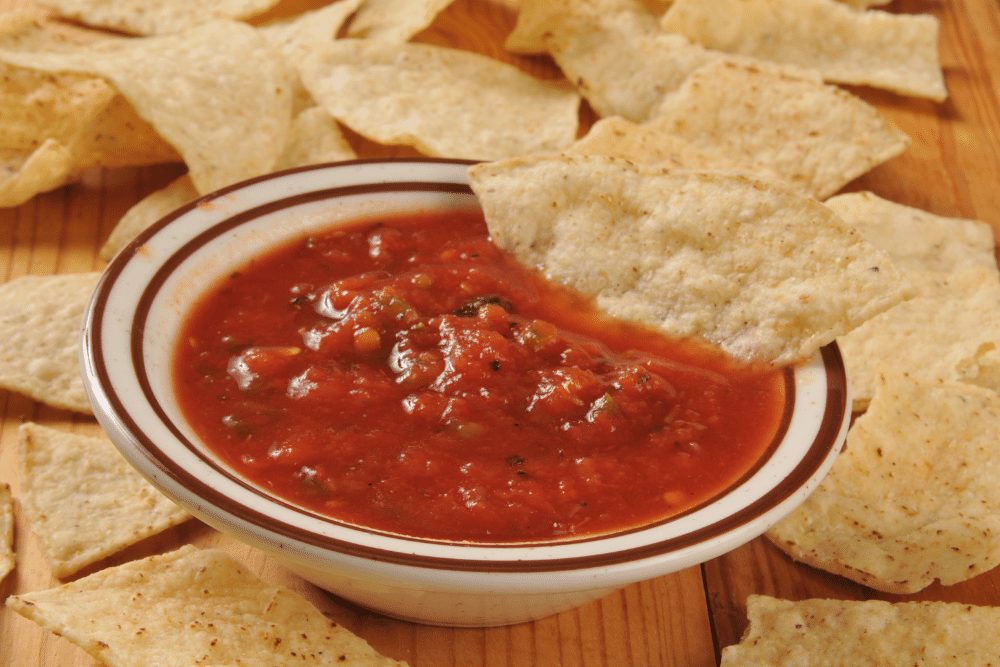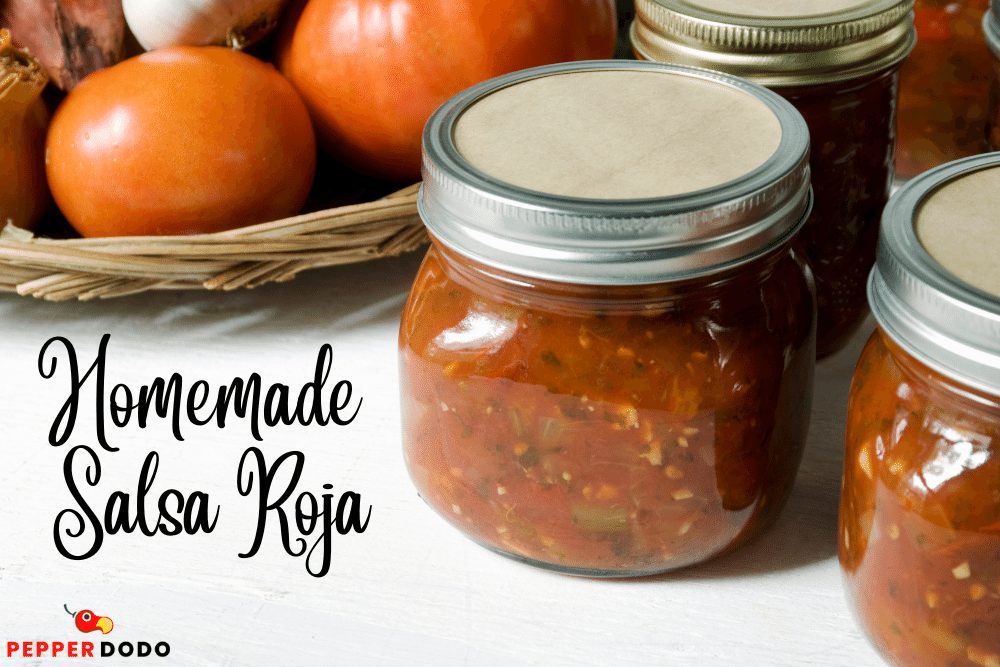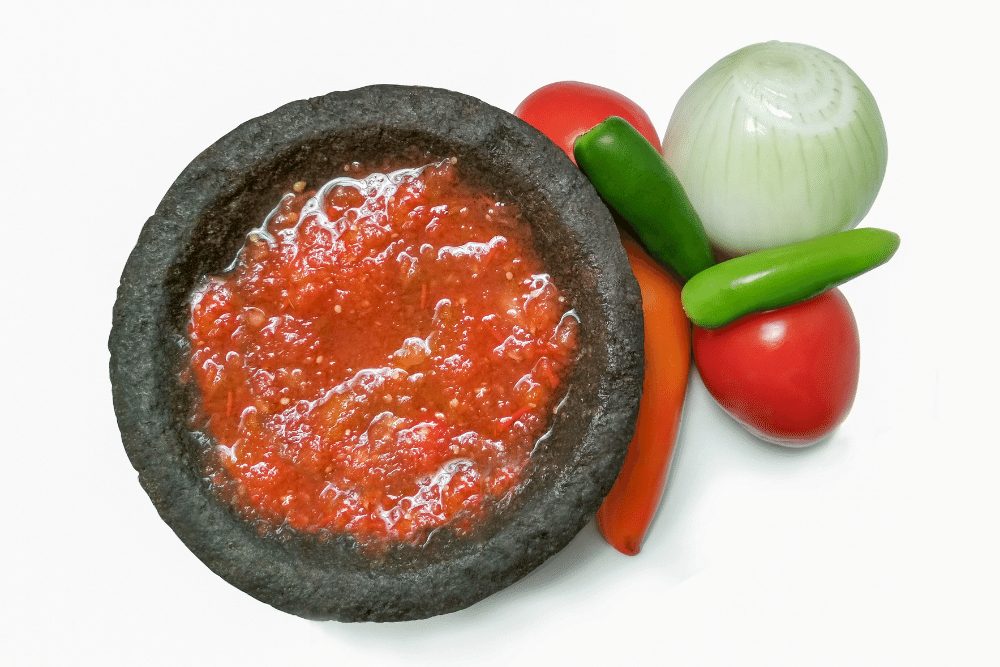Salsa roja is the classic Mexican red sauce served in restaurants alongside a basket of chips. Recipes vary widely, but salsa roja typically contains roma tomatoes, white onions, garlic, lime juice, jalapeno peppers or other chili peppers, and sometimes cilantro. The consistency is thinner, almost a puree depending on the recipe, which makes this salsa double as a pourable sauce and condiment.
What Is Salsa Roja?
Salsa roja translates as red sauce and is one of Mexican cuisine’s most commonly used sauces.
In many cases, it’s treated as a condiment and used in a similar way people use ketchup (and sometimes in place of ketchup).
Unlike ketchup, which has a great deal of refined sugar, salsa roja provides significant nutritional value. The ingredients used are loaded with vitamin A, vitamin C, and potassium, and the method of preparation helps keep it low in calories at approximately 10-30 kcal per 2 tablespoons depending upon the recipe used.
Unlike a pico de’ gallo where the ingredients are fresh and chunky, salsa roja is either roasted or simmered before combining and blending. And it doesn’t stop there. Once blended, many salsa roja recipes call for simmering to intensify the flavors even more.
This versatile sauce has many other applications beyond dipping tortilla chips. Salsa roja is an essential ingredient in a variety of dishes.

What Does Salsa Roja Taste Like?
Answering this question is far more complicated than it seems. The flavor of salsa roja depends very much upon the ingredients used and the steps in preparation.
For instance, peppers are a primary ingredient in salsa roja, but you can use a wide range of chilis. The most common is the serrano pepper, which provides more heat than a jalapeno but less than a habanero.
But even two salsas made using serrano can taste quite different depending upon whether the peppers were roasted or used fresh.
You can also use dried chilis, like chile pasilla or ancho chiles. Including these can create a deeper, richer flavor. Chipotle chilis (smoked jalapeno) are sometimes added, which lends a smokiness to the salsa.
At the most basic level, however, if a salsa roja is made entirely with fresh ingredients, it will have a bright, spicy and fruity flavor.
The flavor will be more intense and deep in flavor if it’s made with dried or canned ingredients.
Generally, salsa roja is a medium-heat sauce rather than high heat. Because it’s used in so many ways, a milder heat creates more versatility and makes it more palatable.
What Are The Main Ingredients In Salsa Roja?
As common as it is, salsa roja recipes can be highly nuanced, with different families or restaurants having their ways of combining the primary ingredients.
In all cases, however, you can count on a particular mix of ingredients to create an authentic salsa roja:
- Tomato
- Onion
- Chilis
- Garlic cloves
- Fresh cilantro
At first glance, this seems simple. But when you dive deeper, you realize there can be huge variations within those simple ingredients in variety, quality, and preparation method.
How To Use Salsa Roja
There are numerous uses for salsa roja, as it can be both a condiment and an ingredient.
The most familiar uses are as an appetizer dip served alongside tortilla chips or as a condiment for tacos, quesadillas, or burritos.
It can also be added to Mexican dishes like huevos rancheros, enchiladas, and chilaquiles.
Because of its versatility, salsa roja lends itself well to creativity.
Add it to:
- Sour cream for a mild, creamy dip.
- Mashed potatoes for a new twist.
- Soup for a spicy, smoky or fresh and fruity flavor.
- Ranch dressing for a punched-up salad.
Salsa roja is also featured in many Tex-Mex recipes. Because Tex-Mex food tends to call for less heat than traditional Mexican recipes, a mild salsa roja is typically used for these dishes.
Why Do All Salsa Rojas Taste Different?
While all salsa rojas may begin with the same primary ingredients, no two homemade salsas ever taste exactly alike. Their distinct, individual flavor is purposeful and based on the personal preferences of the chef.
A variety of chili peppers can be used alone or combined to impact the flavor.
Fresh chili choices are usually:
- Jalapeno, red or green
- Serrano
- Anaheim
Dried chilis are usually one of the following
- Ancho chilis
- Chile de arbol
- Guajillo
- Chipotle
In addition, there may be certain spices and seasonings added, like:
- Lime
- Vinegar
- Olive oil
- Cumin
- Chili powder
- Crushed red pepper flakes
- Coriander
- Oregano
With so many acceptable ingredients, it’s no wonder the flavor profile of salsa roja can vary drastically!

How Long Does Salsa Roja Last?
Although best used fresh, salsa roja can last up to two weeks in the refrigerator in an airtight container. Salsas with more acid (lime or lemon juice) tend to last longer.
Bubbles or a frothy appearance at the top of the salsa may indicate the salsa has gone bad. If there is an overly tangy flavor when you taste it, your salsa is probably past its edible window.
Where To Buy Salsa Roja
Due to its popularity, salsa roja can be purchased in many places. This isn’t the same as the jarred sauce found on shelves, but rather a fresh red salsa.
Most grocery stores will now have fresh salsa available in their refrigerated section, generally near the deli foods or in the produce section. Fresh salsa verde (green salsa made with tomatillos) will often be available in the same area.
Many Mexican restaurants or Latin markets will also sell their signature salsa roja by the quart. Call your favorite spot and ask!
How To Make Salsa Roja
Making your own salsa roja is easy and fun! Since there is variation in flavor, making your own allows you to showcase the ingredients and flavors you enjoy most.
Standard ingredients are easily found in local grocery stores – even the dried chilis, which you can find in the Mexican or Latin aisle. They’re usually sold whole in bags. Unless you’re using chili powder, your recipe will have you reconstitute dried whole chilis in water before pureeing them.
Prep time can vary depending on whether roasting is involved and how long you choose to simmer your sauce after it’s blended.
No special equipment is required either. A food processor is best for combing ingredients, but a blender or immersion/hand blender can also work.
The total time from start to finish is generally about an hour.
Recommended Recipes For Salsa Roja
A quick internet search will net you many salsa roja recipes. Read through and few and choose one with ingredients you like (and can easily find!).
Here are a few to try:

